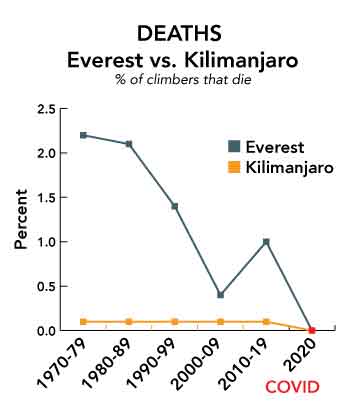A question we get frequently “is climbing Kilimanjaro dangerous?” Like any outdoor adventure activity, it is risky to trek up a 19,341-foot tall mountain. But it shouldn’t deter you from booking a trip. In this article, we examine how dangerous climbing Kilimanjaro is based on past studies.

HOW MANY DEATHS OCCUR ON MOUNT KILIMANJARO?
Unfortunately, it is difficult to gauge an accurate number of deaths on Kilimanjaro. The Kilimanjaro National Park Authority (KINAPA) does not release this data. The reason is likely that the government feels it would negatively impact tourism.
However, a study by Markus Hauser from 1996 to 2003 addressed this topic. In his paper, Deaths Due to High Altitude Illness Among Tourists Climbing Mount Kilimanjaro, Hauser studied autopsies of tourists who died while climbing Kilimanjaro during those eight years. There were 25 deaths. Autopsies are legally required for fatal incidences among tourists in Tanzania. Hauser used this information and concluded that the overall mortality rate was 13.6 deaths per 100,000 climbers. He stated that though altitude sickness occurred frequently among climbers, fatal cases were rare.
A look into the autopsy reports revealed that there were 17 males and eight females. The ages ranged from 29 to 74.
The report states that the deaths were a result of High Altitude Cerebral Edema (HACE) or High Altitude Pulmonary Edema (HAPE), pneumonia, trauma, and one appendicitis.
During the eight years of the study, approximately 20,000 people are year were visiting Kilimanjaro. Now there are close to 40,000 people. Which is double. Logically, that would mean that the number of deaths could have doubled. With that in mind, that would make the mortality rate 13.6 deaths per 100,000 trekkers or 5.4 per year.
Many Kilimanjaro websites post the average number of deaths around 10. There is no evidence to support this figure. Put another way, 0.014% of people climbing Kilimanjaro may die.
By comparison, according to the BBC as of 2018 less than 1% of all climbers attempting Mount Everest died. On average, about 1,000 people attempt Everest a year. On the other hand, the 2019 Everest climbing season took 11 people’s lives. Which pushed that percentage over 1.1%.
To reiterate, climbing Kilimanjaro is dangerous. But don’t have us compare it to riding in a vehicle since we all know that is far more dangerous.
Circling back to Hauser’s findings, he concluded that most of the fatalities were preventable.
 DON’T BE A STATISTIC?
DON’T BE A STATISTIC?
What can you, do to not be one of those statistics? First of all, your guiding company is the single most important fact in making it safely to the summit. They should be medically trained, experienced, and prepared. Choose one that focuses on safety.
Furthermore, you should train and get in great shape. To be in great shape means your body will be able to better tolerate the effects of altitude. Read more here: https://kilimanjarosunrise.com/kilimanjaro-training-program/
Secondly, if you have known medical conditions or are older, go see your doctor and get cleared for high-altitude trekking. Being at high elevations can trigger health complications in those who have pre-existing conditions.
Third, every climber needs to be familiar with the typical symptoms of altitude sickness. When you are on the mountain, be very honest about how you feel. Tell the guides so they can take corrective action.
SAFETY PRACTICES
- Our guides are Wilderness First Responders(WFR) certified
- Our guides go through annual training to handle emergencies on the mountain
- We conduct daily health checks using a pulse oximeter to measure pulse, temperature, blood pressure, and oxygen saturation
- You can rent ALTOX Personal Oxygen Systems, which reduce the likelihood of altitude sickness
- The guides carry emergency oxygen on climbs to combat serious cases of altitude sickness
- We pack first aid kits to treat minor injuries such as blisters, cuts, and abrasions
In case of serious illness or injury we provide, free of charge, AMREF Flying Doctors Helicopter Evacuation Services. See here: https://kilimanjarosunrise.com/kilimanjaro-sunrise-offers-amref-flying-doctors-helicopter-evacuation-free-of-charge/
Our guides perform thorough health checks twice per day for each climber. They keep a log of your stats and review them with you.
The health checks include:
- Taking body temperature with an infrared thermometer
- Checking blood oxygen saturation with a pulse oximeter that attaches to a finger to track your blood oxygen saturation.
- Measure your heart rate also with a pulse oximeter
- Listen to your lungs
HIGH ALTITUDE PULMONARY EDEMA (HAPE)
What is High Altitude Pulmonary Edema (HAPE) and how do you avoid it? HAPE is a life-threatening form of non-cardiogenic pulmonary edema, which is fluid accumulation in the lungs. This can occur in otherwise healthy mountaineers at altitudes typically above 8,200 feet. However, cases have also been reported at lower altitudes such as 4,900–8,200 feet in highly vulnerable subjects. Studies haven’t pinpointed what makes some people susceptible to HAPE. HAPE remains one of the major causes of death related to high-altitude exposure. There is a high mortality rate if you do not get immediate treatment.
Symptoms of HAPE (You need at least two):
- Shortness of breath at rest
- Cough
- Weakness or decreased exercise performance
- Chest tightness or congestion
More severe symptoms:
- Crackles or wheezing (while breathing) in at least one lung field
- Central blue skin color
- Tachypnea (rapid breathing)
- Tachycardia (rapid heart rate)
Being susceptible to HAPE is difficult to predict. There may be a genetic predisposition to the condition. People with sleep apnea may also be more susceptible due to irregular breathing patterns while sleeping at high altitudes. Studies have shown that HAPE occurs in less than 1% of climbers exposed to altitudes above 13,000 ft. The standard—and most important treatment—is to descend to a lower altitude as quickly as possible. Oxygen should also be given if possible. Symptoms tend to quickly improve with a descent. More severe symptoms may continue for several days. Furthermore, drug treatments are also available.
The U.S. Army has conducted tests for over 30 years. They performed these studies by exposing sea-level volunteers rapidly and directly to high altitudes. Of the 300 volunteers, only three had to be evacuated due to possible HAPE.
HIGH ALTITUDE CEREBRAL EDEMA (HACE)
Another risk climbers take is getting High Altitude Cerebral Edema (HACE). HACE is a severe and sometimes fatal form of altitude sickness that results from capillary fluid leakage. This is due to the effects of hypoxia on the mitochondria-rich endothelial cells of the blood-brain barrier.
Symptoms include:
- Headache
- Loss of coordination (ataxia)
- Weakness
- Disorientation
- Memory loss
- Psychotic symptoms (hallucinations and delusions)
- Coma
Cerebral edema can result from brain trauma or nontraumatic causes. These causes can range from ischemic stroke, cancer, or brain inflammation due to meningitis or encephalitis. But with climbing, it is due to fast travel to high altitudes without proper acclimatization. Four types of cerebral edema have been identified: Vasogenic, Hydrostatic Cerebral Edema, Cytotoxic, and High Altitude Cerebral Edema. HACE generally occurs after a week or more at high altitudes. If not treated quickly, severe cases may result in death. Immediate descent by 2,000 – 4,000 feet is a crucial life-saving measure. Medications such as dexamethasone can be prescribed for treatment in the field. Proper training in their use is required. Therefore, anyone suffering from HACE should be evacuated to a medical facility for proper follow-up treatment.
In Conclusion
If the need arises, which is rare, our guides can coordinate rescue and evacuation with other staff, the park service, and AMREF Flying Doctors Helicopter Evacuation Service. Our guides have the ability to contact our Arusha staff at any point in case of an emergency. Climbing Kilimanjaro is dangerous, but with proper training, expert guides, and being prepared, you should have no issues when it comes to fulfilling your dream of standing on the summit of Kilimanjaro.

 DON’T BE A STATISTIC?
DON’T BE A STATISTIC?


